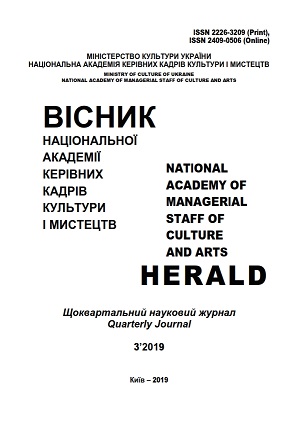British Heritage and its Influence on the Maltese Culture
British Heritage and its Influence on the Maltese Culture
Author(s): Larysa Vasylivna Guba, Yulia Anatoliyivna Rybinska, Taisiia Ponochovna-RysakSubject(s): Cultural history, Recent History (1900 till today), Cultural Anthropology / Ethnology, Culture and social structure , Sociology of Culture, 19th Century
Published by: Національна академія керівних кадрів культури і мистецтв
Keywords: ties between the United Kingdom and Malta; British Heritage; the Maltese Culture; English language; integration of cultures; the influence of British; a British colony; British governorship; the blend
Summary/Abstract: Purpose of the article. The article highlights the ties between the United Kingdom and Malta and it is shown that they are indissoluble. They run deep, go back centuries, and are founded on mutual respect in good times and bad. The author, Jesmond Grech, rightly dwells on the period from 1800, when the Royal Navy and the people of Malta struck up a friendship which was built to last throughout and beyond the period of British rule, and which embraced the Army and the RAF, through the dark years of World War II and to the present day. Today, Malta‘s self-evident European vocation and Britain‘s continuing friendship go band in the band. Among the visible signs are the English language, education choices, tourism, culture – including football – trade and investment. Not to mention Leyland buses, red pillar boxes, and phone kiosks, and abiding affection for things British. With the acquisition of Malta, the British had gained an indispensable Mediterranean naval base. The Grand Harbour area, especially the dockyard was given the utmost consideration. As technological developments constantly the Admiralty invested in the modernization of the harbour facilities. With the opening of the Suez Canal (1869) the naval traffic which passed through Malta on its way to or from India multiplied considerably. Consequently two docks, the Somerset Dock (1871) and the Hamilton Dock (1892) were constructed to meet the demands of heavier shipping. At Vittoriosa one can still see the hub of the Victualling Yard, the Naval Bakery. In this place the Navy‘s daily bread supplies were prepared by the use of steam-powered machinery. The building was constructed according to the design of William Scamp, a British architect and military engineer, between 1842 and 1845. Previously, the site served as the covered slipways from which the Order‘s ships were launched. Presently the building is the premises of the Maritime Museum and houses an interesting collection of naval memorabilia from Punic to modern times. In 1903 the construction of the breakwaters at the entrance of the Grand Harbour was commenced. The foundation stone of this project was laid by King Edward VII himself on April 20th 1903. Work on this massive construction project was to provide the livelihood to hundreds of workers and their families for the next three years. Consequently, the initial years of the 20th century augured well. Things, however, began to turn sour both in the local and international scene. Conclusions. The aim of the article is to highlight Malta`s benefit from increased defense spending by Britain. Although Malta remained heavily dependent on British military spending, successive British governors brought advances in medicine, education, industry and agriculture to Malta. The British legacy in Malta is evident in the widespread use of the English language in Malta today. English was adopted as one of Malta's two official languages in 1936, and it has now firmly replaced Italian as the primary language of tertiary education, business, and commerce in Malta.
Journal: Вісник Національної академії керівних кадрів культури і мистецтв
- Issue Year: 2019
- Issue No: 3
- Page Range: 32-36
- Page Count: 5
- Language: English

